|
Flipper - Latest Version 1.5 |
 |
|
|
|
 |
|
| |
|
|

|
|
All use of this game is covered by this
Creative Commons Deed.
Please do not use this game for any commercial purposes, thank you. |
|
|
Flipper is a new and exciting puzzle game based on a tile board system.
In this game, you must clear each level of various coloured tiles as you move around the board.
As you progress further into the game special tiles are introduced to create more complex ways of
completing each level. The game can be played at your own pace and access to all levels is
available from the start of the game. (no special unlocking of levels required)
The game features:
- 6 coloured and 6 special tiles used to create engaging puzzles
- 30 levels of various difficulty which can be played at your own pace
- Built-in puzzle editor which can be used to change or create brand new puzzles
- All levels are stored in a text format which can easily be emailed to friends and family
- The game is free to download and covered by the
Creative Commons Deed
Enjoy
Sims
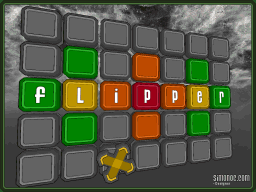 |
|
| History |
For a long time now I have been playing with various graphically game making
Tools
and experimenting with several doodle ideas.
You know the sort of idea's I am talking about ...
"Wouldn't it be awesome if I made this game like XYZ game, but this time with bigger guns and more
stuff to play with! OMG that rocks, more stuff!"
|
|
|
Usually I start out with a simple idea, but often it rapidly turns into a 1000 leg scripting monster
which eventually crashes and eats itself to save me anymore frustration. Despite the fact that most
game making tools have simple drag and drop game logic interfaces they often fall down on lack of
good documentation.
Starting with a simple idea and sticking to it is very closely is important, because part of the learning curve for
any game making system is coming to terms with the limitation of the engine and trying to bend it around
your ideas.
Recently while surfing a news site I saw a post saying that Garage Games had done some major update to their Torque engine and I was curious. I had heard about the Torque engine before,
but never really considered it friendly to non-binary people. To my surprise they had a demo version of their
new game making tool set, so I downloaded it.
After a couple of hours of making fish swim back and forth across my screen I was hooked. The game making
system had a nice interface and a very powerful C style scripting language which is always fun to play with. Now, all
I need to do is come up with a simple idea and stick to it!
|
|
| Keeping it simple
|
I started out with a simple puzzle game involving moving tiles around a grid. Nothing ground
breaking as far as design goes, but it was a good starting point.
The learning curve of any new toolset always takes time and there is no point trying to implement complex
graphical tasks if you don't know the basic steps first like ... where is everything stored?
|
|
|
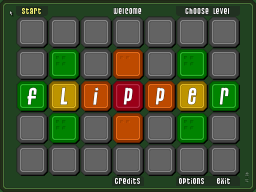
|
|
After several days of trawling forums and documentation I finally created my first prototype. It was very rough
around the edges but it worked and I could move stuff around the grid. I added the different tile colours in order
to give the game a bit more complexity and created a couple of levels to see how well it played.
My first test of the prototype with friends was a bit disappointing because everyone found the game too easy. Since
the path through every level was in a linear line, the possibilities of making something difficult was well ... difficult.
A friend of mine suggested adding more depth to the game by having more tile types. This could be bombs, traps or
various other types of obstacles on the grid. I liked the idea of more tile types, but I wanted them to interact with what
was there, not simple just be more stuff. I always liked games where as you get new stuff it adds more depth to what you already
have, not simply replace it.
With the prototype done and mixed feedback from friends on what the game could be it was time to do some more planning.
I knew if I broke the design down into smaller tasks it would not seem so daunting to complete. So, I stopped for a
while and went back to thinking on paper until I had more of idea of what I wanted to achieve with the game.
This is the main reason I enjoy this type of project so much, is that you are involved in the whole process
from beginning to end. Sadly, due to the complexity of modern game development and the crazy amount of time required
to complete anything, it is extremely rare to be involved in anything but a small part of the overall game nowadays.
The development of my little puzzle game was turning out to be a lot of fun and it was interesting to think about
all the different components that make a game for a change.
|
|
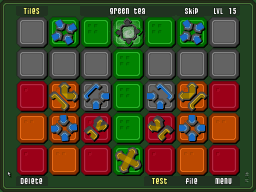
|
|
| Oh yeah, it's Puzzle Time!
|
I spent ages thinking about what I wanted from the game. What sort of game play would it be? How complex
do I want the puzzles to be? How much time would someone spend on each level?
I knew the answer to a lot of these questions would come from what type of special tiles I add to
the game. So, I decided to implement a couple of special tiles and see how they play.
|
|
|
I created the Exploder tile and Arc variant first and tried them out on some new levels. The initial results
were very promising but I wanted to double check with some friends first and see how well they played the levels.
It was awesome to see other people playing through the game and trying to complete the puzzles. I tried
to setup a couple of puzzles that could only be done in a certain way, but my friends found new solutions.
Everyone who tested the game had a different style of play and it was fascinating to watch.
With the first two special tiles setup it was time to finish off the remaining four and see how complex the puzzles
could be. At this point the game was really rough because all the levels were created via text
files and stored in one pack. It seemed like a crazy idea at the time but I needed a level editor!
Being someone who uses level editors a lot, I tried to create a design flow that made the most sense to me. I implemented
the rest of the special tiles and editor at the same time and it made level creation a millions easier and much more fun.
|
|
| My creation has a name, it's alive!
|
With the editor built and a working version of the game functional, I needed to store multiple levels and
not have them setup in one file. It was not something I really needed, but after a while became
more essential.
The file menu was initially just a single load and save but I had a couple of friends testing the game
and wanting to store their puzzles in different locations, so I needed to add more.
|
|
|
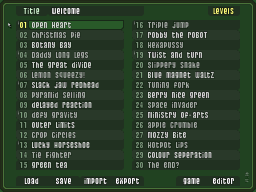
|
|
The level names did not originally exist, we all referred to the puzzles we swapped by level numbers.
For some reason it seemed like a logical thing to add because when you create a puzzle you don't want to refer to it
as a number, you want to name it!
With so many puzzles being created we all wanted a simple way to share these with each other and not have to edit
text files anymore. The import / export feature was designed to be a quick way to share stuff (via email) and it worked
really well.
Most of the original levels were created via a text editor, so it was important for me to make the file format really
easy to edit. This also made the flow of test maps between friends a lot easier and saved me a lot of time debugging later on.
|
|
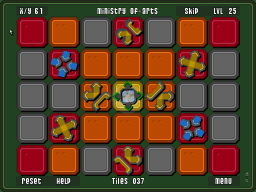
|
|
| Finally the game is finished!
|
I have had an awesome time creating this game and it was amazing to see what other people
did with it. I have probably spent close to a month of my spare time working on this game and it still
feels like I could add more!
I had a ton of cool ideas from different friends but I had to draw the line on features and simple
finish the game, maybe next time.
|
|
|
If you played this game and want to let me know what you think of it, then contact me on the email address at the
bottom of the page. If you create any level packs that you think are amazing, then please let me know.
|
|
| Simon OC |
Game Design, Art & Levels |
| Jon Zuk |
Additional Ideas & Testing |
Testing & Support
Pat Williams, Joel McDonald, Tom Odell,
Fred Hooper & Gabriella Kiszely.
Garage Games for a cool engine.
|
|
|
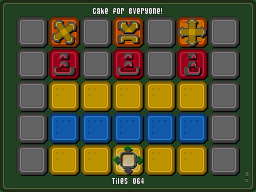
|
|
|
|
|
|
 |
|
|
|













